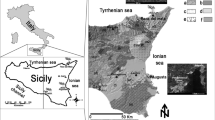Abstract
During the last few years human scalp hair, a horny fibrous derivative of the skin, became well recognized as an invaluable tissue for monitoring human environmental exposure. The sequential accumulation of a number of elements in particular (growth rate of hair strands ca 0.3 mm/day), the fact that the concentrations of trace elements in hair are at least an order of magnitude greater than in the body fluids and other accessible tissues, as well as the simple obtainment and the easy preparation of the specimen, reveal the advantages of this test material. Therefore systematic analyses of concentrations and distribution of arsenic, antimony, cadmium, mercury, bromium and zinc in hair samples obtained from population groups of four Austrian provinces (Bundesländer) were accomplished by INAA. The selection of those regions are based on the distinct economic structure caused by the geographical location as well as the heterogenous geological structure of the country.
Zusammenfassung
Die vorliegende Studie zeigt, daß die Analyse von Spurenelementen (z.T. toxische Metalle) im menschlichen Kopfhaar einen wertvollen Beitrag liefern kann die Umweltbelastung verschiedener Bevölkerungsgruppen abzuschätzen.
Mit Hilfe der instrumentellen Aktivierungsanalyse sind Haaranalysen einfach und gut reproduzierbar durchzuführen, nicht zuletzt deshalb, weil die Elementkonzentrationen in Haaren zumindest eine Größenordnung höher liegen als in den Körperflüssigkeiten, die ja auch als Untersuchungsobjekte dienen.
Similar content being viewed by others
Literatur
S. GANGADHARAN, M. DAS SANKAR, Report to AGM on Applications of Nuclear Methods in Environmental Research, Vienna, 1976.
I. M. DALE, J. M. A. LENIHAN, H. SMITH, Proc. 2nd Int. Conf. on Nuclear Methods in Environmental Research, J. R. VOGT, W. MEYER (Eds) ERDA, 1975.
I. D. HAMMER, Amer. J. Epidemiol., 93 2 (1971) 84.
A. CHATTOPAHYAY, R. E. JERVIS, Proc. Symp. on Trace Substances in Environmental Health, Columbia, Missouri, 1974, p. 31.
T. L. ATALIA, C. M. SILVA, F. W. LIMA, An. da Acad. Brasiliera de Ciéncias, 37 (65) No. 3/4, 433.
J. M. A. LENIHAN, I. M. DALE, AGM on Applications of Nucl. Meth. in Environm. Research, Vienna, 1976.
H. AL-SHAHRISTANI, Report to IAEA, 1976.
B. TIEFENBACH, E. R. JERVIS, Annual Report, Slowpoke Nuclear Reactor at the Univ. of Toronto (July 1974–June 1975) Toronto, 1975, p. 59.
S. GANGADHARAN, M. SANKAR DAS, J. Radioanal. Chem. 15 (1973) 287.
A. CHATTOPADHYAY, T. ROBERTS, R. E. JERVIS, Rep. of the Inst. for Environmental Studies, Univ. of Toronto, Ontario, Canada, 1975.
J. A. VAN DER BERG, M. DE BRUIN, J. P. W. HOUTMAN, Nuclear Activation Techniques in the Life Sciences, IAEA, Vienna, 1967, p. 661.
J. M. A. LENIHAN, H. SMITH, Nuclear Activation Techniques in the Life Sciences, IAEA, Vienna, 1967 p. 601.
A. A. GORDUS, D. C. MAHER, G. C. BIRD, Proc. 1st Annual NSF Trace Contaminants Conf., Oak Ridge Nat. Lab., 1973 p. 463.
S. OHMORI, T. MIURA, Y. KUSAKA, H. TSUJI, T. SAGAWA, Y. TAMARI, Radioisotopes (Tokyo), 24 (1975) 396.
Author information
Authors and Affiliations
Rights and permissions
About this article
Cite this article
Lanzel, E. Aktivierungsanalyse von Umwelt-Metallen in Menschlichem Kopfhaar. J. Radioanal. Chem. 58, 347–357 (1980). https://doi.org/10.1007/BF02533806
Received:
Published:
Issue Date:
DOI: https://doi.org/10.1007/BF02533806




